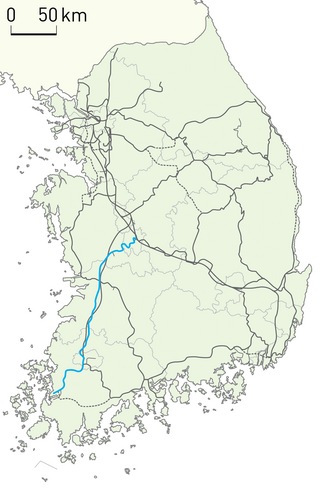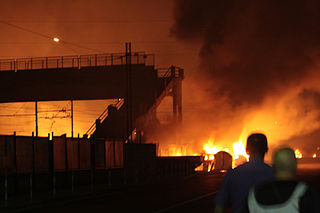| Iri Station Explosion | |
|---|---|
| Details | |
| Date | 11 November 1977 |
| Location | Iri, now Iksan |
| Coordinates | 35°56′26″N126°56′47″E / 35.94062°N 126.94636°E |
| Country | South Korea |
| Incident type | Munitions Explosion |
| Statistics | |
| Trains | 1 |
| Deaths | 59 |
| Injured | 1300+ |
The Iri station explosion was a disaster that occurred in Iri, North Jeolla, South Korea on November 11, 1977, at 9:15 p.m. About 40 tons of dynamite carried in a freight train Gwangju exploded at Iri station. The town and train station have both been rechristened as Iksan. At least 59 people were killed. [1]
The explosion killed 59 people and seriously injured 185 others; [2] altogether, over 1,300 people were injured. At the time, the population of Iri numbered around 130,000 people. [3]
The force of the explosion carved a crater ten meters deep and thirty meters wide. Most structures within a 500-meter radius from the site of the explosion were severely damaged. Approximately 9,500 buildings were affected by the explosion, which left about 10,000 people without a home. Residential apartment buildings, the city's first, were constructed to accommodate the displaced. [3]
Financial damage was extensive; property losses alone were estimated to be ₩23 billion won; [4] the government allocated ₩13 billion won for the recovery effort. [5] [6]
Transportation Minister Choi Kyung-rok resigned soon thereafter. [3]

Iksan is a city and major railway junction in North Jeolla Province, South Korea.

The Honam Line is a major railway line serving the Honam region in South Korea. The line is served by frequent passenger trains from Seoul to Gwangju and Mokpo.

The Jeolla Line (Korean: 전라선) is a railway line in North and South Jeolla Provinces in South Korea. The line is served by frequent passenger trains from Seoul to Yeosu.
The Ryongchŏn disaster was a train disaster that occurred on 22 April 2004 in the town of Ryongchŏn, North Korea, near the border with the People's Republic of China. At least 54 people were killed, including some Syrian scientists.
There have been many extremely large explosions, accidental and intentional, caused by modern high explosives, boiling liquid expanding vapour explosions (BLEVEs), older explosives such as gunpowder, volatile petroleum-based fuels such as gasoline, and other chemical reactions. This list contains the largest known examples, sorted by date. An unambiguous ranking in order of severity is not possible; a 1994 study by historian Jay White of 130 large explosions suggested that they need to be ranked by an overall effect of power, quantity, radius, loss of life and property destruction, but concluded that such rankings are difficult to assess.
The railways of New South Wales, Australia have had many incidents and accidents since their formation in 1831. There are close to 1000 names associated with rail-related deaths in NSW on the walls of the Australian Railway Monument in Werris Creek. Those killed were all employees of various NSW railways. The details below include deaths of employees and the general public.

Iksan station is on South Korea's high-speed KTX railway network, 243 km south of Yongsan station.
The Arzamas explosion, also known as the Arzamas train disaster, was a railway accident that occurred on June 4, 1988, in Arzamas, Gorky Oblast, Soviet Union, when an explosion at a railway crossing killed 91 people and injured 1,500. The Arzamas train disaster occurred exactly a year before the Ufa train disaster, one of the deadliest railway accidents in Soviet and Russian history.

The Viareggio derailment was the derailment and subsequent fire of a freight train carrying liquefied petroleum gas. It occurred on 29 June 2009 in a railway station in Viareggio, Lucca, a city in Central Italy's Tuscany region. Thirty-two people were killed and a further twenty-six were injured.
There have been a number of train accidents on the South Australian railway network. The first known incident in this list occurred in 1873 in Smithfield.

The Braamfontein Explosion was an explosion of a freight train carrying dynamite in Braamfontein, a suburb of Johannesburg, in 1896. It was one of the largest non-nuclear explosions in history.
Events from the year 1977 in South Korea.
The 1995 Daegu gas explosions occurred at the Daegu Metro Line 1 construction site in Sangin-dong, Daegu, South Korea, on April 28, 1995. The explosion resulted in the death of at least 101 people, including 42 Yeongnam Middle School students, with as many as 202 people injured.
The news agency said the explosion was much more powerful than a blast in the southern South Korean city of Iri in 1977 when a freight train carrying dynamite blew up, killing 56 people and injuring 1,300.